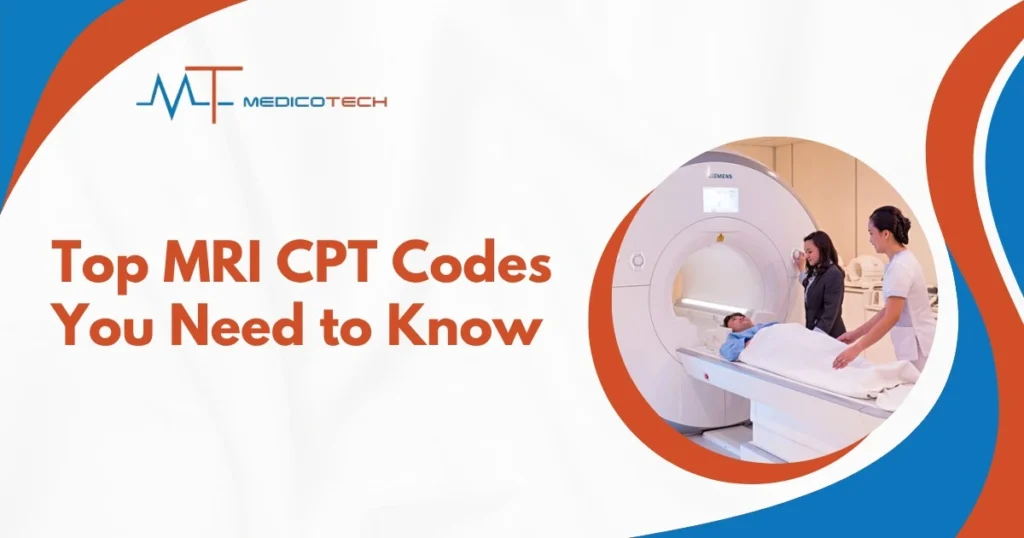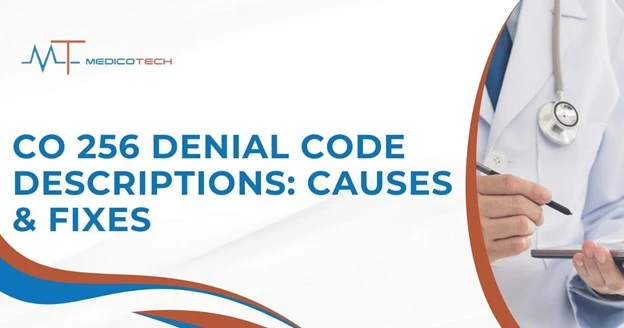What Are CPT Codes?
Current Procedural Terminology (CPT) codes are standardized alphanumeric identifiers developed by the American Medical Association (AMA) to document medical, surgical, and diagnostic services. These codes facilitate accurate billing, reimbursement, and data collection across the healthcare industry.
Importance of MRI CPT Codes
Magnetic Resonance Imaging (MRI) is a critical diagnostic tool that provides detailed images of internal structures without the use of ionizing radiation. Proper coding of MRI procedures ensures appropriate reimbursement, adherence to insurance requirements, and effective communication among healthcare providers, while improving the accuracy of medical billing services and credentialing services.
Most Commonly Used MRI CPT Codes
Brain and Head Imaging
- 70551: MRI Brain without contrast
- 70552: MRI Brain with contrast
- 70553: MRI Brain with and without contrast
Spine Imaging
- 72141: MRI Cervical Spine without contrast
- 72142: MRI Cervical Spine with contrast
- 72156: MRI Cervical Spine with and without contrast
- 72146: MRI Thoracic Spine without contrast
- 72147: MRI Thoracic Spine with contrast
- 72157: MRI Thoracic Spine with and without contrast
- 72148: MRI Lumbar Spine without contrast
- 72149: MRI Lumbar Spine with contrast
- 72158: MRI Lumbar Spine with and without contrast
Musculoskeletal Imaging
- 73218: MRI Upper Extremity Non-Joint without contrast
- 73220: MRI Upper Extremity Non-Joint with and without contrast
- 73221: MRI Upper Extremity Joint without contrast
- 73222: MRI Upper Extremity Joint with contrast
- 73223: MRI Upper Extremity Joint with and without contrast
- 73718: MRI Lower Extremity Non-Joint without contrast
- 73720: MRI Lower Extremity Non-Joint with and without contrast
- 73721: MRI Lower Extremity Joint without contrast
- 73722: MRI Lower Extremity Joint with contrast
- 73723: MRI Lower Extremity Joint with and without contrast
Abdominal and Pelvic Imaging
- 74181: MRI Abdomen without contrast
- 74182: MRI Abdomen with contrast
- 74183: MRI Abdomen with and without contrast
- 74185: MRA Abdomen without contrast
- 74186: MRA Abdomen with contrast
- 74187: MRA Abdomen with and without contrast
- 72195: MRI Pelvis without contrast
- 72196: MRI Pelvis with contrast
- 72197: MRI Pelvis with and without contrast
Breast Imaging
- 77046: MRI Breast unilateral without contrast
- 77047: MRI Breast unilateral with and without contrast
- 77048: MRI Breast bilateral without contrast
- 77049: MRI Breast bilateral with and without contrast
MRI CPT Codes by Body Part / Anatomy
Brain and Head
- Non-Contrast vs. Contrast-Enhanced:
- 70551: MRI Brain without contrast
- 70552: MRI Brain with contrast
- 70553: MRI Brain with and without contrast
- 70551: MRI Brain without contrast
- Functional MRI (fMRI) Codes:
- 70554: Functional MRI of the brain
- 76377: 3D rendering with post-processing
- 70554: Functional MRI of the brain
Spine
- Cervical Spine MRI:
- 72141: MRI Cervical Spine without contrast
- 72142: MRI Cervical Spine with contrast
- 72156: MRI Cervical Spine with and without contrast
- 72141: MRI Cervical Spine without contrast
- Thoracic Spine MRI:
- 72146: MRI Thoracic Spine without contrast
- 72147: MRI Thoracic Spine with contrast
- 72157: MRI Thoracic Spine with and without contrast
- 72146: MRI Thoracic Spine without contrast
- Lumbar Spine MRI:
- 72148: MRI Lumbar Spine without contrast
- 72149: MRI Lumbar Spine with contrast
- 72158: MRI Lumbar Spine with and without contrast
- 72148: MRI Lumbar Spine without contrast
Musculoskeletal
- Joint MRI (Knee/Shoulder/Hip):
- 73721: MRI Knee without contrast
- 73722: MRI Knee with contrast
- 73723: MRI Knee with and without contrast
- 73221: MRI Shoulder without contrast
- 73222: MRI Shoulder with contrast
- 73223: MRI Shoulder with and without contrast
- 73721: MRI Hip without contrast
- 73722: MRI Hip with contrast
- 73723: MRI Hip with and without contrast
- 73721: MRI Knee without contrast
- Extremity MRI:
- 73718: MRI Lower Extremity Non-Joint without contrast
- 73719: MRI Lower Extremity Non-Joint with contrast
- 73720: MRI Lower Extremity Non-Joint with and without contrast
- 73718: MRI Lower Extremity Non-Joint without contrast
Abdominal & Pelvic
- Liver/Kidney MRI:
- 74181: MRI Abdomen without contrast
- 74182: MRI Abdomen with contrast
- 74183: MRI Abdomen with and without contrast
- 74181: MRI Abdomen without contrast
- Pelvic Floor Imaging:
- 72195: MRI Pelvis without contrast
- 72196: MRI Pelvis with contrast
- 72197: MRI Pelvis with and without contrast
- 72195: MRI Pelvis without contrast
MRI vs. MRA CPT Codes: Key Differences
Understanding MRA (Angiography) Codes
- MRA:
- 70544: MRA Head without contrast
- 70545: MRA Head with contrast
- 70546: MRA Head with and without contrast
- 70549: MRA Neck with and without contrast
- 70544: MRA Head without contrast
When to Use MRI vs. MRA Codes
- MRI: Used for detailed imaging of soft tissues, such as the brain, spine, and joints.
- MRA: Specifically used for imaging blood vessels to assess conditions like aneurysms, stenosis, and vascular malformations.
Code Pairing Scenarios
- In cases where both soft tissue and vascular imaging are required, both MRI and MRA codes may be used in conjunction, ensuring comprehensive diagnostic information.
CPT Code Guidelines for MRI Procedures
Contrast Administration Rules
- Contrast agents are used to enhance the visibility of internal structures.
- The appropriate CPT code should be selected based on whether contrast is administered:
- Without contrast
- With contrast
- With and without contrast
- Without contrast
Bilateral Procedure Coding
- When an MRI is performed on both sides of the body (e.g., bilateral knees), the appropriate modifier should be applied to indicate the bilateral nature of the procedure.
Modifiers Explained (TC/26/59)
- TC (Technical Component): Indicates the technical services provided, such as equipment use and technician support.
- 26 (Professional Component): Indicates the professional services provided, such as the interpretation of the MRI images.
- 59 (Distinct Procedural Service): Used to indicate that a procedure was distinct or independent from other services performed on the same day.
Supervision & Documentation Requirements
- Proper documentation is essential to justify the need for the MRI and to support the billing process.
- Documentation should include patient history, clinical indications, and any relevant findings from previous imaging studies.
Billing and Reimbursement Best Practices
Technical vs. Professional Components
- Understanding the distinction between the technical and professional components of MRI services is crucial for accurate billing and reimbursement.
Avoiding Denials: Top 5 Mistakes
- Incorrect or missing modifiers.
- Failure to obtain prior authorization when required.
- Inaccurate coding of contrast usage.
- Lack of proper documentation.
- Billing for unbundled services when bundled codes should be used.
Prior Authorization Strategies
- Implementing a robust prior authorization process can help prevent claim denials and ensure timely reimbursement.
Medicare/Medicaid Specifics
- Be aware of specific billing requirements and coverage policies for MRI procedures under Medicare and Medicaid programs.
Recent Updates to MRI CPT Codes
2024-2025 Code Changes
- Stay informed about the latest updates to MRI CPT codes to ensure compliance and accurate billing.
Deleted/Combined Codes
- Be aware of any codes that have been deleted or combined to avoid billing errors.
New Specialty-Specific Codes
- New codes may be introduced to reflect advancements in MRI technology and specialized imaging techniques.
FAQs About MRI CPT Coding
How to Code Multi-Part Scans?
- When multiple body parts are imaged during a single MRI session, each area should be coded separately, applying the appropriate modifiers as needed.
Unlisted Procedure Code Use
- Unlisted procedure codes should be used sparingly and only when a specific code does not exist for the service provided.
Coding With/Without Contrast Simultaneously
- If both contrast and non-contrast images are obtained during the same MRI session, the appropriate codes should be used to reflect each part of the procedure.




